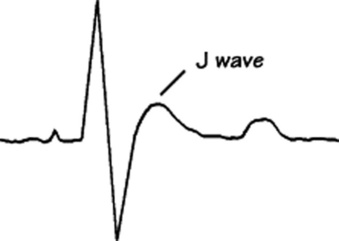Chapter 67 Hypothermia
4 What are some risk factors for hypothermia?
| Trauma | Rescue |
| Severe illness | Transport |
| Immersion or submersion | Resuscitation |
| Exposure to wind or cold air | Intoxication, especially with: |
| Central nervous system illness or injury | Alcohol |
| Hypothalamic dysfunction | Barbiturates |
| Endocrine impairment | Phenothiazines |
| Metabolic impairment | Burns and weeping dermatoses |
| Iatrogenic causes | Child abuse (e.g., cold water baths) |
5 What clinical clues should prompt measurement of core temperature?
 Any of the above risk factors (including, but not limited to, any critical care patient)
Any of the above risk factors (including, but not limited to, any critical care patient)
 Decreased mental status, respiration, or circulation without other obvious cause
Decreased mental status, respiration, or circulation without other obvious cause
 A J (Osborne) wave on electrocardiogram (Fig. 67-1) is diagnostic when present, but is seen in only about 10–80% of cases in various series.
A J (Osborne) wave on electrocardiogram (Fig. 67-1) is diagnostic when present, but is seen in only about 10–80% of cases in various series.
Nolan J, Soar J: Images in resuscitation: The ECG in hypothermia. Resuscitation 64:133, 2005.
6 How should temperatures be taken to detect hypothermia?
Danzl DF, Pozos RS: Accidental hypothermia. N Engl J Med 331:1756, 1994.
7 Define mild, moderate, and severe hypothermia
 Mild hypothermia: Temperature ranges from approximately 32° to 35° C. In this range, the body attempts to combat heat loss by shivering, increasing metabolism and vasoconstriction.
Mild hypothermia: Temperature ranges from approximately 32° to 35° C. In this range, the body attempts to combat heat loss by shivering, increasing metabolism and vasoconstriction.
 Moderate hypothermia: Temperature spans the range from 28° to 32° C. In this range, compensatory mechanisms begin to fail, and mental status may be altered.
Moderate hypothermia: Temperature spans the range from 28° to 32° C. In this range, compensatory mechanisms begin to fail, and mental status may be altered.
 Severe hypothermia: Temperature (< 28° C) leads to failed thermoregulation, metabolic shutdown, and paradoxical vasodilatation accompanied by hypovolemia, decreased perfusion, and stupor or coma.
Severe hypothermia: Temperature (< 28° C) leads to failed thermoregulation, metabolic shutdown, and paradoxical vasodilatation accompanied by hypovolemia, decreased perfusion, and stupor or coma.
10 What rules of advanced life support may be altered in hypothermia?
KEY POINTS: HYPOTHERMIA IN CHILDREN
1 Children are particularly prone to hypothermia, especially with serious illness or injury.
2 Serious hypothermia often goes undetected by clinicians without a high degree of suspicion.
3 Although it may provide for an occasional remarkable recovery after prolonged resuscitation, hypothermia is generally harmful.
4 Moderate and severe hypothermia alter standard resuscitation measures.






